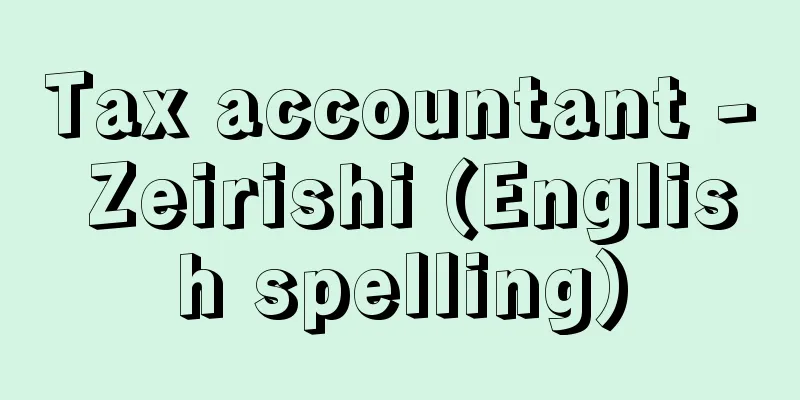Tax accountant - Zeirishi (English spelling)

|
Tax professionals. Their mission is to ensure that taxpayers are paid appropriately from an independent and fair standpoint (Article 1 of the Tax Accountant Law). Tax reforms based on the Shoup recommendations after the Second World War (adoption of the self-assessment tax system and blue tax return system, etc.) led to the establishment of the Tax Accountant Law in 1951 (Showa 26) to replace the Tax Agents (established in 1942). Their duties mainly consist of tax and accounting work, and are as follows: (1) Tax agents who act on behalf of clients in filing returns, applications, claims, appeals, and other claims against tax audits and dispositions based on tax law; (2) Tax document preparation, such as preparing returns and applications to be submitted to the tax office; (3) Tax consultation, providing advice on matters related to the calculation of tax assessment bases, etc. in connection with the preparation of tax returns, claims, statements, returns, etc.; (4) Accounting services such as preparing financial documents and recording accounting books in addition to the work of a tax accountant; (5) Litigation assistants who appear and make statements together with a litigation representative (lawyer) in litigation regarding taxes. The requirements for a certified tax accountant are to pass the Certified Public Tax Accountant Examination, to be exempt from all subjects of the Certified Public Tax Accountant Examination (such as those who have worked in tax affairs at a tax office for a certain period of time), to be a lawyer, or to be a certified public accountant. A person becomes a certified public tax accountant by registering as required by the Certified Public Tax Accountant Law. The examination consists of two accounting subjects (bookkeeping and financial statements) and three tax law subjects of the examinee's choice (Income Tax Law, Corporation Tax Law, Inheritance Tax Law, Consumption Tax Law or Liquor Tax Law, National Tax Collection Law, Resident Tax or Business Tax, Fixed Asset Tax). Candidates do not need to take all five subjects at once, and may take one subject at a time. As of the end of March 2010, there were 15 Certified Public Tax Accountant Associations and the Japan Federation of Certified Public Tax Accountants' Associations, which comprises the Certified Public Tax Accountant Associations as members, with a total of 71,606 registered members. In addition, the Tax Accountant Law was amended in 2001 to create a new tax accountant corporation system (Article 48-2 of the Tax Accountant Law) for the purpose of conducting tax accountant work in an organized manner with two or more tax accountants as employees. As of the end of March 2010, 1,949 corporations were registered. [Yoshito Nakamura] "The Duties and Responsibilities of Tax Accountants - In Search of the Ideal Tax Accountant," 3rd Edition, by Matsuzawa Satoshi (1995, Chuo Keizai-sha)" ▽ "Risk Management for Tax Accountant Firms," by Torikai Shigekazu, Hongo Hisashi, and Sanefuji Hideshi (1996, Roppo Publishing)" ▽ "Research into the Tax Accountant System," by Kitano Hirohisa, expanded edition (1997, Tax Accountant Association)" ▽ "Tax Accountant Firms of the 21st Century," revised edition, edited by Mizuno Tadatsune and Nakazato Minoru and edited by Nisshinkai (1999, Tax Accountant Association)" ▽ "Tax Accountants of the Future," edited by Abe Tatsushi and Suzuki Masaoki (1999, Tokyo Shoten)" ▽ "Everything About the Tax Accountant Corporation System," by Uyama Shoichiro (2001, Chuo Keizai-sha)" ▽ "The New Tax Accountant Law," edited by the Japan Federation of Certified Public Tax Accountants' Associations (2002, Tax Accountant Association)" ▽ "Torikai Shigekazu (ed.), Uchida Kumiko (ed.), "Duties, Powers and Responsibilities of Tax Accountants: The System of the New Tax Accountant Law and Its Interpretation" (2002, Chuo Keizaisha) Source: Shogakukan Encyclopedia Nipponica About Encyclopedia Nipponica Information | Legend |
|
税務に関する職業専門家。独立した公正な立場において納税義務の適正な実現を図ることを使命とする(税理士法1条)。第二次世界大戦後のシャウプ勧告に基づく税制改革(申告納税制度や青色申告制度の採用など)によって、それまでの税務代理士(1942年制定)にかわるものとして、1951年(昭和26)税理士法が制定され生まれた。業務の内容は、主として税務業務と会計業務があり、具体的には以下のようである。 (1)税法に基づく申告、申請、請求、不服申立てなど税務調査や処分に対する主張について代理、代行する税務代理、(2)税務署に提出する申告書や申請書等の書類を作成する税務書類作成、(3)税務申告や主張、陳述、申告書等の作成に関し、租税の課税標準等の計算に関する事項について相談に応ずる税務相談、(4)税理士業務に付随して財務書類の作成、会計帳簿の記帳の代行などの会計業務、(5)租税に関する訴訟において訴訟代理人(弁護士)とともに出頭・陳述する訴訟の補佐人。 税理士資格の要件は、税理士試験の合格者、税理士試験の全科目免除者(税務署などで一定期間税務事務に従事した者など)、弁護士、公認会計士である。税理士法に定める登録により税理士となる。試験は、会計学の科目(簿記論、財務諸表論)の2科目と税法の科目(所得税法、法人税法、相続税法、消費税法または酒税法、国税徴収法、住民税または事業税、固定資産税)のうち受験者の選択する3科目である。受験者は一度に5科目を受験する必要はなく、1科目ずつ受験してもよい。2010年(平成22)3月末現在15の税理士会と、各税理士会を会員とする日本税理士会連合会が組織されており、登録者数は7万1606人である。なお、2001年の税理士法の改正により、2名以上の税理士を社員として税理士業務を組織的に行うことを目的とする税理士法人制度が新設された(税理士法48条の2)。2010年3月末現在、1949法人が登録されている。 [中村義人] 『松沢智著『税理士の職務と責任――期待される税理士像を求めて』第3版(1995・中央経済社)』▽『鳥飼重和・本郷尚・実藤秀志著『税理士事務所のリスク対策』(1996・六法出版社)』▽『北野弘久著『税理士制度の研究』増補版(1997・税務経理協会)』▽『水野忠恒・中里実監修、日進会編『21世紀の税理士事務所』改訂版(1999・税務経理協会)』▽『安部辰志・鈴木正興編『これからの税理士』(1999・東京書店)』▽『右山昌一郎著『よくわかる税理士法人制度のすべて』(2001・中央経済社)』▽『日本税理士会連合会編『新税理士法』(2002・税務経理協会)』▽『鳥飼重和監修、内田久美子編『税理士の業務・権限・責任――新税理士法の体系とその解釈』(2002・中央経済社)』 出典 小学館 日本大百科全書(ニッポニカ)日本大百科全書(ニッポニカ)について 情報 | 凡例 |
>>: Menstrual leave - Seirikyuuka
Recommend
Akagi
Akagi Village was formerly a village in Seta Dist...
Complete guide to actors from ancient times to the present
A commentary on Kabuki. The main author was Tada N...
Monologue - Dokuhaku
〘noun〙① In a play, when a character speaks lines b...
Decreased motivation - Iyokugentai
...When this abnormally increases and one act aft...
Kineya Katsugoro (first generation)
...The twelve transformations for the twelve mont...
zone index fossils
…Among the echinoderms, primitive stalked fossils...
Megara
…Afterwards, having been taught military arts and...
Mayow, J.
...In the 17th century, G. Galilei confirmed that...
Mitrasacme alsinoides (English spelling) Mitrasacme alsinoides
… [Mitsuru Hotta]... *Some of the terminology tha...
Neutral hydrogen cloud
The part of the galaxy where the concentration of ...
Female Gidayu - Onnagidayu
Gidayu storytelling by women. It is also called &...
Motoyoshi - Kiko
…After Seishin's death, he studied esoteric B...
Sugen-in Temple
Tokugawa Hidetada's wife. Mother of Iemitsu. ...
Kosai [town] - Kosai
An old town in the southwest of the Kofu Basin, Na...
Present Noh - Genzainou
Types of Noh based on the content. Noh plays that ...









